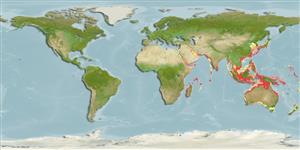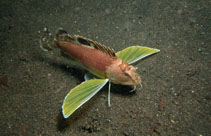Add your observation in Fish Watcher
| Native range | All suitable habitat | Point map | Year 2050 |

|
| This map was computer-generated and has not yet been reviewed. |
| Apistus carinatus AquaMaps Data sources: GBIF OBIS |
Upload your photos and videos
Pictures | Google imageApistus carinatus
Picture by Zuberbuhler, T.
Pictures | Google imageApistus carinatus
Picture by Zuberbuhler, T.
Classification / Names Nombres comunes | Sinónimos | Catalog of Fishes(Género, Especie) | ITIS | CoL | WoRMS | Cloffa
> Perciformes/Scorpaenoidei (Scorpionfishes) > Apistidae (Wasp scorpionfishes)
Etymology: Apistus: Greek, apisto = uncertain (Ref. 45335).
More on authors: Bloch & Schneider.
Etymology: Apistus: Greek, apisto = uncertain (Ref. 45335).
More on authors: Bloch & Schneider.
Issue
Genus Hypodytes, according to Paxton et al. 1989 (Ref. 7300).
Environment: milieu / climate zone / depth range / distribution range Ecología
marino demersal; rango de profundidad 14 - 60 m (Ref. 30573), usually 15 - 50 m (Ref. 4313). Deep-water
Distribución Países | Áreas FAO | Ecosistemas | Ocurrencias, apariciones | Point map | Introducciones | Faunafri
Indo-West Pacific: Red Sea and the Persian Gulf south to Natal, South Africa and east to India and the Philippines, north to China and Japan, south Australia.
Tamaño / Peso / Age
Maturity: Lm ? range ? - ? cm
Max length : 20.0 cm TL macho / no sexado; (Ref. 48635); common length : 10.0 cm TL macho / no sexado; (Ref. 3503)
Max length : 20.0 cm TL macho / no sexado; (Ref. 48635); common length : 10.0 cm TL macho / no sexado; (Ref. 3503)
Short description Claves de identificación | Morfología | Morfometría
Espinas dorsales (total) : 14 - 16; Radios blandos dorsales (total) : 8 - 10; Espinas anales: 3 - 4; Radios blandos anales: 6 - 8. Bluish grey in color, belly pale; large black spot on rear half of spinous dorsal (Ref. 4313).
Inhabits soft bottoms of the continental shelf. Primarily known from trawls over prawn-grounds but divers looking in suitable habitats can come across them, especially at night. During the day it buries itself deep in the sand with just the eyes exposed. When disturbed, it spreads its long pectoral fins with the bright upper color to deter predators. It uses its fins to corner prey and has sensitive barbels below the mouth to detect those buried in the substrate (Ref. 48635). Fin spines venomous (anterolateral glandular groove with venom gland (Ref. 57406)) (Ref. 30573). Sold in small quantities either fresh or dried and salted in markets. Minimum depth reported taken from Ref. 57178.
Life cycle and mating behavior Madurez | Reproducción | Puesta | Huevos | Fecundidad | Larva
Main reference
Upload your references | Referencias | Coordinador | Colaboradores
Poss, S.G. and K.V. Rama Rao, 1984. Scorpaenidae. In W. Fischer and G. Bianchi (eds.) FAO species identification sheets for fishery purposes. Western Indian Ocean (Fishing Area 51). Vol. 4. FAO, Rome. pag. var. (Ref. 3503)
CITES
Not Evaluated
Threat to humans
Venomous (Ref. 4716)
Human uses
Pesquerías: escaso valor comercial
FAO - Publication: search | FishSource |
Más información
Trophic ecology
componentes alimenticios
Composición de la dieta
consumo de alimento
Food rations
Despredadores
componentes alimenticios
Composición de la dieta
consumo de alimento
Food rations
Despredadores
Population dynamics
Coeficiente del crecimiento para
Max. ages / sizes
Length-weight rel.
Length-length rel.
Length-frequencies
Mass conversion
Reclutamiento
Abundancia
Coeficiente del crecimiento para
Max. ages / sizes
Length-weight rel.
Length-length rel.
Length-frequencies
Mass conversion
Reclutamiento
Abundancia
Life cycle
Reproducción
Madurez
Maturity/Gills rel.
Fecundidad
Puesta
Spawning aggregations
Huevos
Egg development
Larva
Dinámica larvaria
Reproducción
Madurez
Maturity/Gills rel.
Fecundidad
Puesta
Spawning aggregations
Huevos
Egg development
Larva
Dinámica larvaria
Anatomy
Superficie branquial
Brain
Otolith
Superficie branquial
Brain
Otolith
Physiology
Body composition
Nutrients
Consumo del oxígeno
Tipo de natación
Velocidad de natación
Visual pigments
Fish sound
Diseases & Parasites
Toxicity (LC50s)
Body composition
Nutrients
Consumo del oxígeno
Tipo de natación
Velocidad de natación
Visual pigments
Fish sound
Diseases & Parasites
Toxicity (LC50s)
Genetics
Genética
Heterozygosity
heritabilidad
Genética
Heterozygosity
heritabilidad
Human related
Aquaculture systems
Perfiles de acuicultura
Razas
Ciguatera cases
Stamps, coins, misc.
Aquaculture systems
Perfiles de acuicultura
Razas
Ciguatera cases
Stamps, coins, misc.
Herramientas
E-book | Guía de campo | Claves de identificación | Asistente para frecuencias de tallas | Herramienta de ciclo de vida | Mapa de puntos | Classification Tree
| Catch-MSY |
Special reports
Download XML
Fuentes de Internet
AFORO (otoliths) | Aquatic Commons | BHL | Cloffa | BOLDSystems | Websites from users | Check FishWatcher | CISTI | Catalog of Fishes: Género, Especie | DiscoverLife | ECOTOX | FAO - Publication: search | Faunafri | Fishipedia | Fishtrace | GenBank: genome, nucleotide | GloBI | Google Books | Google Scholar | Google | IGFA World Record | MitoFish | Bases de datos nacionales | Otolith Atlas of Taiwan Fishes | PubMed | Reef Life Survey | Socotra Atlas | Árbol de la vida | Wikipedia: Go, búsqueda | World Records Freshwater Fishing | Expediente Zoológico
Estimates based on models
Preferred temperature (Ref. 123201): 23.3 - 29, mean 28 °C (based on 1680 cells).
Phylogenetic diversity index (Ref. 82804): PD50 = 1.1250 [Uniqueness, from 0.5 = low to 2.0 = high].
Bayesian length-weight: a=0.01175 (0.00443 - 0.03114), b=3.02 (2.80 - 3.24), in cm total length, based on LWR estimates for this (Sub)family-body shape (Ref. 93245).
Nivel trófico (Ref. 69278): 3.6 ±0.4 se; based on size and trophs of closest relatives
Fishing Vulnerability (Ref. 59153): Low vulnerability (10 of 100).




